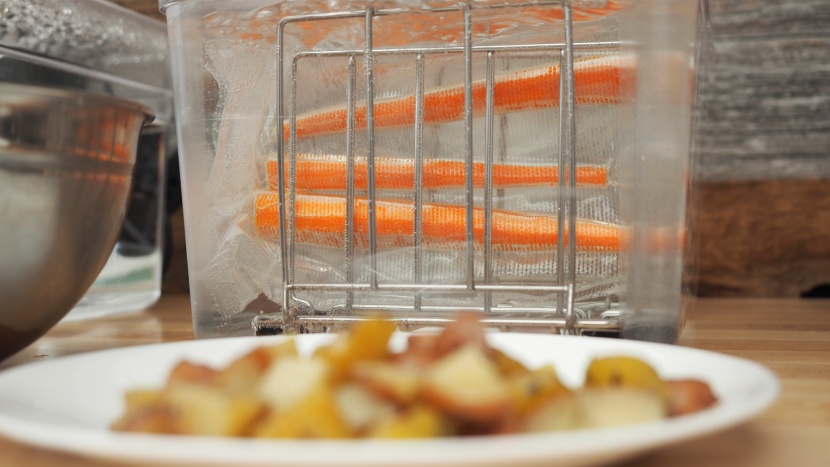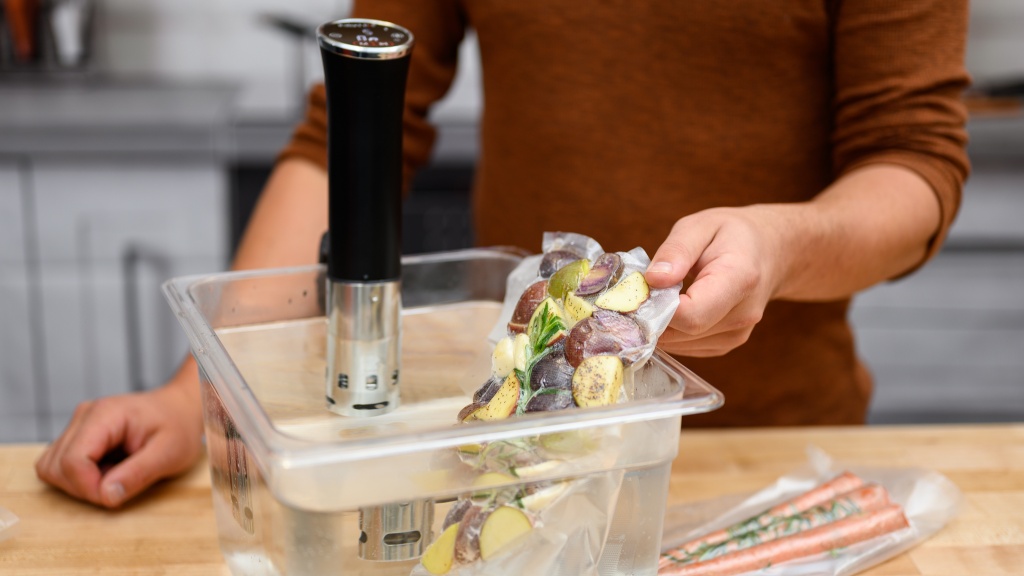Wondering if a top-rated sous vide machine is the solution to all of your kitchen woes? If you have been hearing all sorts of things about this trendy cooking method and trying to figure out where to start, we are here to help. We bought all the best immersion circulators to test head-to-head and spent dozens and dozens of hours with these products. We then took all that expertise and put this guide together to help you decide if you need a sous vide cooker, explain what they can do and the different types, and show you what to look for when shopping for a new one.
What is Sous Vide Cooking?
Sous Vide (sue-veed) — French for “under vacuum” — refers to the process of cooking food in a precisely controlled water bath, usually in a vacuum sealed bag. Cooking time and temperature is dependent on the type of food, which then can be finished by searing or grilling to add texture and flavor. While this may seem like a recently developed technique given the equipment required and all the hype, it has actually been used by high-end restaurants and other foodservice operations for decades. Unfortunately, this commercial equipment was usually too expensive, too large, and too difficult to use for most home chefs, excluding amateurs from this type of cooking.
However, there has been a recent boom of low-cost, user-friendly immersion circulators that have drastically increased the availability and popularity of sous vide as a cooking technique, as a quick search on YouTube or online recipe sites will instantly reveal guides to sous vide-ing everything from custards to crab.
What's it Used For?
While all the hype may lead you to believe that you should abandon all other forms of cooking in favor of sous vide, this isn't really the case. Sous Vide is essentially a more technical form of slow cooking, but allows for a lot more options and control compared to the typical slow cooker. It also makes it much easier to cook the perfect medium-rare on a steak, keep chicken breasts moist and juicy, or even soft-boil the perfect ramen egg. Essentially, it allows you to swap out some of the necessary skills to achieve this with traditional cooking techniques with science.
For example, it is essentially impossible to achieve a perfect medium-rare from edge to edge when cooking a steak in a pan. The pan's temperature is well above the correct temperature for medium-rare, so by the time the interior of the steak has reached the proper temperature, the outsides are overcooked. Sous vide cooking prevents overcooking by only ever heating up the meat to the correct cooking temperature.
Am I Going to Get Sick? These Cooking Temps are Really Low…
If you have ever taken a ServSafe or other food safety class, then you might start to wonder as soon as you look at some sous vide recipes, as they are well under what is typically the recommended cooking temperature by the USDA. For example, a typical sous vide recipe for chicken breasts calls out cooking them at 145–150°F (63–66°C) while the USDA recommends that chicken be cooked to an internal temperature of 160°F. Now, before you start to panic and write angry comments to the thousands of food YouTubers exalting sous vide cooking, it's important to understand where these temperatures come from and what they mean. In the case of poultry, this temperature is determined by what it takes to instantaneously cause a 7-log reduction of Salmonella bacteria, which means that only 1 out of 10,000,000 survive.
However, these bacteria begin to die off as soon as the temperature is above 130°F, it just takes longer. It takes 37 minutes at 135°F or 12 minutes at 140°F to achieve the same level of lethality. Essentially, you are pasteurizing your food when sous vide cooking. Your actual cooking time will be much longer than the listed pasteurizations times as well, as you need to take into account the time it takes for the interior of the food to heat up to the pasteurization temperature, as the timer doesn't start until it reaches that temperature.
Needless to say, this doesn't mean that you should take food safety lightly when using a sous vide machine. For the most part, you should always get recipes from a legitimate source and not really improvise — unless you really know what you are doing — since you aren't cooking food to the instantaneous Salmonella kill temperature.
Cooking in Plastic?
Now that you are past the low cooking temperatures, the next major concern you have is cooking your food in a plastic pouch, which is the typical go-to option for everything besides eggs and custards/cheesecakes/etc. in mason jars. Unfortunately, we can't give you a definitive answer about this — since no one really can. Sous vide manufacturers usually recommend using food-safe high-density polyethylene, low-density polyethylene, or polypropylene. These plastics are definitely not the “bad” plastics that leach Bisphenol-A or Phthalates like polycarbonate or PVC but we wouldn't necessarily go so far as to call them a “good” plastic, as there are some studies that have shown some leaching with almost any plastic. Essentially, the jury is still out on how much some of these plastics leach, if there are even any health effects from those leached materials, and there are almost no studies about plastic leaching under sous vide conditions.
Based on our research, we feel comfortable using high-grade vacuum sealing bags or zip-top freezer bags, though it really comes down to your own personal feelings and you really should conduct your own research if you are that concerned about it. If you are 100% against cooking your food in plastic, you can always limit your sous vide cooking to eggs in the shell or other recipes that use a mason jar.
There are also companies that make reusable silicone sous vide pouches that can even be vacuum sealed if you are concerned more about the single-use nature of typical bags. We do recommend that you are very careful about avoiding cross contamination with these products, since you are using them to store raw meat and need to be decontaminated throughout before reuse.
Step 1: Immersion Circulator or Water Oven?
Now that we have gotten past what sous vide cooking is and addressed some of the most common concerns with it, it's time to pick out which type of sous vide cooker is right for you — if we haven't completely scared you off this cooking process, that is. There are two main appliances that home chefs can use to sous vide food: immersion circulators and water ovens/all-in-one sous vide machines. Immersion circulators are basically a cylinder with a heating element, thermostat, and a water pump. You provide the container — a stock pot works great — fill it with water, set the temperature and time on the circulator, and you are all set. Immersion circulators are compact, convenient, and usually much less expensive than all-in-one options.
Water ovens have all the same functionality as an immersion circulator but have a built-in water tank, so all you need to do is fill them up and they are ready to go. However, this makes them quite large and you have no flexibility when it comes to container size, so you are out of luck if your food doesn't fit.
Overall, we would almost always recommend an immersion circulator over a water oven. They are just so much easier to store and have significant cost savings.
Step 2: How Much Power?
Once you start looking at immersion circulators, you will notice that their power output in watts is the main quantifiable spec advertised. First and foremost, this power output has almost nothing to do with how your food cooks; more power does not equal faster cooking. Each sous vide machine has a precision control for temperature, so they all should take the same amount of time to cook something once they are up to temperature. However, a more powerful heater will take less time to heat the water up initially and recover faster when you add large food items to the bath. A higher wattage sous vide machine will also have an easier time combating heat loss when cooking at higher temperatures. However, you can always help out a lower wattage sous vide machine by adding a lid to the pot or wrapping it in a towel for extra insulation. We generally wouldn't worry too much about the power rating unless you are routinely cooking giant roasts or other large cuts of meat, as the time to recover after adding those with less powerful machines can start to add up.
Step 3: Smart Sous Vide?
The last feature to consider when shopping for a sous vide is whether you want it to connect to your smartphone or tablet. There are models that can only be controlled through a connected device, ones that have no connectivity at all and have an interface and display right on top, or ones that have both.
While we think it seems a bit egregious to have your sous vide machine controlled by Alexa, the connected devices can be quite handy. You can scroll through their library of recipes or save your own, as well as check in on your device from across the house. It's not a make or break feature but it is useful enough to consider and we would recommend going this route if you do use your smartphone for most things and don't mind one more connected device at home — how much personal data can they really get from an immersion circulator anyways, right? Plus, these seem relatively harmless for when the robot AI uprising occurs.
If you absolutely loathe connected devices and refuse to add one more with a sous vide machine, there is no need to worry. You can still make exceptional food in a manually controlled machine — you just might want to keep a notebook handy to record the settings for all your successes and failures.
Even More Equipment to Buy?
Once you have picked out the perfect sous vide machine, you also want to consider what else you might need to buy. Starting out, you can 100% get away with a large stock pot and some heavy-duty zip-top bags, but you are definitely going to want to consider buying a vacuum sealer and dedicated sous vide container with a lid or even a rack if you are routinely cooking this way.
Conclusion
Hopefully, this has helped cut through all the confusion and concerns with cooking “under vacuum” and has helped you find the perfect sous vide circulator for your needs and budget. Now get cooking!















